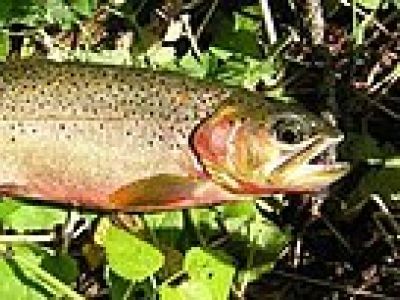F-ONCL-LE-Cutthroat Trout, lewisi Subspecies

Cutthroat Trout, lewisi Subspecies
Oncorhynchus clarkii lewisi
- Phylum: Craniata
- Class: Actinopterygii
- Order: Salmoniformes
- Family: Salmonidae
The westslope cutthroat trout (Oncorhynchus lewisi) is a freshwater salmonid in the cutthroat trout complex. The westslope cutthroat trout is a species of concern in Montana and British Columbia.
General Information
Key Habitat Features
Spawn in small, low gradient stream tributaries with stable flow, gravel substrates, low sediment loads and temperatures approximately from 7-10 C.
Riparian vegetative cover is important adjacent to spawning areas.
Rearing in small tributaries with gravel and cobble substrate, along the stream margins and off-channel habitat.
Overwintering pools, with deep water (>2 m), slow velocity flow, with optimal cover consisting of boulders, bedrock or large organic debris, occur in large mainstem streams.
Objectives
Maintain the hydrologic characteristics of the site when activities are planned within identified habitat, including: cover, substrate quality, pool depth and volume, large woody debris, groundwater flow, water quality, temperature, and channel structure..
Plan activities so that key habitat features remain available for use throughout all seasons.
Planning and Operational Measures
All Activities
Identify key habitat features using appropriate measures (i.e. QP direction, desktop review, field confirmation, etc) and plan activities within the operating area accordingly.
Observe riparian setbacks.
Avoid planning stream crossings within spawning locations and migration corridors.
All Activities
Undertake construction and operation of oil and gas activities in a manner that minimizes impacts to desired plant communities and key habitat features.
Timing considerations:
As per EPMG Section 1.6.3.3 Timing Window Guidance for HPW, the proponent must consider and plan riparian works and/or stream crossings within “least risk windows” for Aquatic species in the Peace Region. Refer to Section 4.8 of the Oil and Gas Activity Application Manual for additional information regarding Changes in and About a Stream.
General guidance: overwintering: September 30 to April 15, spawning April 15 to July 15, rearing July 15 to March 31
Linear Features
All
Upon completion of the activity, undertake the following measures to encourage re-establishment of the pre-disturbance ecological trajectory:
deactivate unnecessary access corridors,
undertake measures to control access,
promote natural or assisted regeneration.
Construct necessary crossings to the highest standards to minimize risk of sediment input or impacts to the channel.